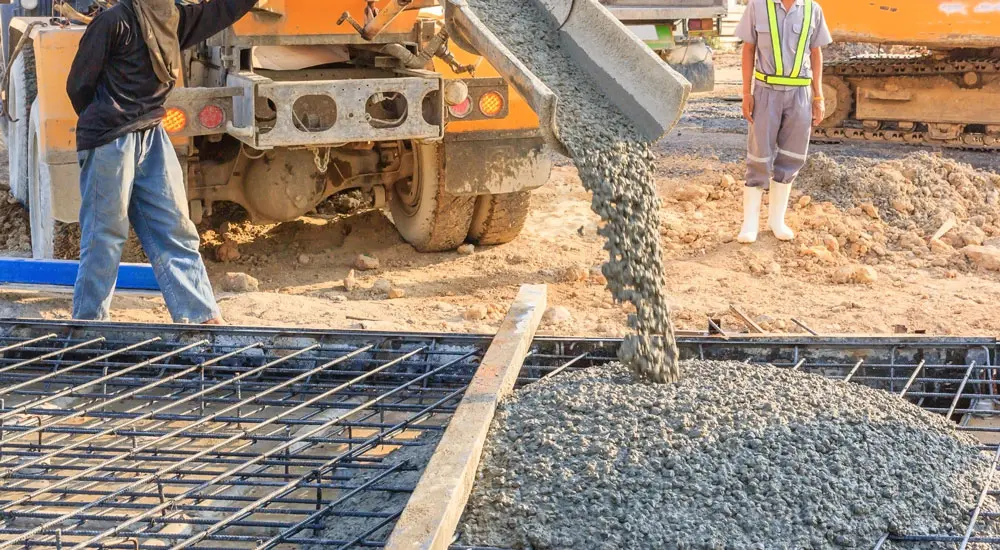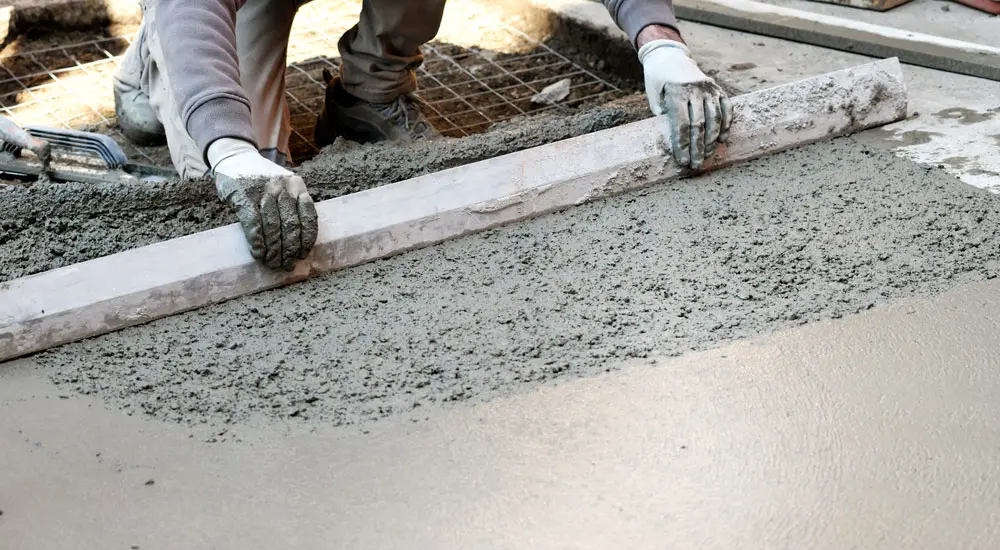The concrete is a composite material composed of fine and coarse aggregate bonded together with a fluid cement (cement paste) that hardens (cures) over time. In the past, lime-based cement binders were often used, such as lime putty, but sometimes with other hydraulic cement, such as a calcium aluminate cement or with Portland cement to form Portland cement (for its visual resemblance to Portland stone). Many other non-cementitious types of concrete exist with different methods of binding aggregate together, including asphalt concrete with a bitumen binder, which is frequently used for road surfaces, and polymer concretes that, well, uses polymers as a binder.
Concrete Definition
Water cement ratio plays an important role which influences various properties such as workability, strength and durability. The adequate water-cement ratio is required for the production of workable concrete definition. When water is mixed with materials, cement reacts with water and hydration reaction starts. This reaction helps ingredients to form a hard matrix that binds the materials together into a durable stone-like material.
Concrete can be cast in any shape. Since it is a plastic material in the fresh state, various shapes and sizes of forms or formworks are used to provide different shapes such as rectangular, circular etc.
Various structural members such as beams, slabs, footings, columns, lintels etc. are constructed with a concrete definition. ACI 318 Building code requirements for structural concrete and ACI 301 Specifications for Structural are used in the United States as a standard code of practice for this construction.
There are different types of admixtures which are used to provide certain properties. Admixtures or additives such as pozzolans or superplasticizers are included in the mixture to improve the physical properties of the wet mix or the finished material. Various types of this are manufactured these days for construction of buildings and structures. These have special properties and features which improve quality of construction as per requirement.

Components
Cement, sand, aggregates and water are the components of concrete. A mixture of Portland cement and water is called a pasta. So, concrete can be described as a mixture of paste, sand, and aggregates, although sometimes rocks are used in place of aggregates
The cement paste coats the surface of the fine and coarse aggregates when mixed thoroughly and binds them. Soon after mixing the components, hydration reaction starts which provides strength and a rock-solid is obtained.
Production
It is the process of mixing together the various ingredients – water, aggregate, cement, and any additives – that produces concrete. It is also important to note that production is time-sensitive. Once the ingredients are mixed, workers must put the concrete in place before it hardens. Nowadays, production is in a large industrial facility, most often called a batch plant, or in a concrete plant.
In general usage, concrete plants come in two main types, ready mix plants and central mix plants. A ready-mix plant mixes all the ingredients except water, while a central mix plant mixes all the ingredients including water. A central mix plant offers more accurate control of the concrete quality through better measurements of the amount of water added, but must be placed closer to the work site where it will be used since hydration begins at the plant.
Plants consist of large storage hoppers for various reactive ingredients like cement, storage for bulk ingredients like aggregate and water. As well as mechanisms for the addition of various additives and amendments, machinery to accurately weigh, move, and mix some or all of those ingredients, and facilities to dispense the mixed concrete, often to a mixer truck.
Modern concrete is usually prepared as a viscous fluid, so that it may be poured into forms, which are containers erected in the field to give it its desired shape. Concrete formwork can be prepared in several ways, such as slip forming and steel plate construction. Alternatively, concrete can be mixed into dryer, non-fluid forms and used in factory settings to manufacture precast products.
A wide variety of equipment is used for processing concrete, from hand tools to heavy industrial machinery. Whichever equipment builders use, however, the objective is to produce the desired building material; so the ingredients must be properly mixed, placed, shaped, and retained within time constraints.
Any interruption in pouring the concrete can cause the initially placed material to begin to set before the next batch is added on top. This creates a horizontal plane of weakness called a cold joint between the two batches. Once the mix is where it should be, the curing process must be controlled to ensure that the concrete attains the desired attributes. During the preparation, various technical details may affect the quality and nature of the product.
Concrete Grade
Grades of concrete are defined by the strength and composition and the minimum strength the concrete should have following 28 days of initial construction. The grade of concrete is understood in measurements of MPa, where M stands for mix and the MPa denotes the overall strength.
Concrete mixes are defined in ascending numbers of 5, starting at 10, and show the compressive strength of the concrete after 28 days. For instance, C10 has the strength of 10 newtons, C15 has the strength of 15 newtons, C20 has 20 newtons strength and so on. Different mixes (M) come in various mix proportions of the various ingredients of cement, sand and coarse aggregates. For instance, M20 comes in the respective ratio of 1:1:5:3. You can see other examples below in the table.
| Concrete Grade | Mix Ratio (cement: sand: aggregates) |
Compressive Strength | |
|---|---|---|---|
| MPa (N/mm2) | psi | ||
| Grades of Concrete Definition | |||
| M5 | 1 : 5 : 10 | 5 MPa | 725 psi |
| M7.5 | 1 : 4 : 8 | 7.5 MPa | 1087 psi |
| M10 | 1 : 3 : 6 | 10 MPa | 1450 psi |
| M15 | 1 : 2 : 4 | 15 MPa | 2175 psi |
| M20 | 1 : 1.5 : 3 | 20 MPa | 2900 psi |
| Standard Grade of Concrete | |||
| M25 | 1 : 1 : 2 | 25 MPa | 3625 psi |
| M30 | Design Mix | 30 MPa | 4350 psi |
| M35 | Design Mix | 35 MPa | 5075 psi |
| M40 | Design Mix | 40 MPa | 5800 psi |
| M45 | Design Mix | 45 MPa | 6525 psi |
| High Strength Concrete Definition Grades | |||
| M50 | Design Mix | 50 MPa | 7250 psi |
| M55 | Design Mix | 55 MPa | 7975 psi |
| M60 | Design Mix | 60 MPa | 8700 psi |
| M65 | Design Mix | 65 MPa | 9425 psi |
| M70 | Design Mix | 70 MPa | 10150 psi |
Choosing the right definition grade for the construction job:
So what can these grades be used for and which is best for the job at hand? Below is a list of a few of the initial grades and what they are best used for.
C10
Used for: Patio slabs, pathways and non-structural work
Type: Domestic & commercial use
C15
Used for: Pavement kerbs and floor blinding
Type: Domestic & Commercial
C20
Used for: Domestic floors and foundations (where the weight of the structure will be lighter). Also good for workshop bases, garages, driveways and internal floor slabs.
Type: Domestic
C25
Used for: Construction in all areas. Multi-purpose concrete mix, usually used for foundations.
Type: Domestic & Commercial
C30
Used for: Pathways and roadways (this is the lowest grade concrete mix that can be used for this purpose). More durable than the grades that have come before, and thus is much more weather-resistant and can take heavy road traffic.
Type: Commercial
C35
Used for: Commercial structures. This heavy concrete mix is usually used for creating external walls and slabs, as well as for structural piling.
Type: Commercial
C40
Used for: Commercial construction sites, creating foundations and beams for structural support and roads. The most durable in this list, C40 can withstand chemical corrosion also, so is frequently used on farms where slurry could corrode structures, or in septic tanks.
Type: Commercial

How to Make Concrete?
Concrete is manufactured or mixed in proportions of cement quantity. There are two types of mixes: nominal mix and design mix. The nominal mix is used for normal construction works such as small residential buildings. The most popular nominal mix is in the proportion of 1:2:4.
Design mixed concrete is for finalizing mix proportions based on various cylinder or cube lab tests for its compressive strength. This process is also called mix design. These tests are conducted to find a suitable mix based on locally available material to obtain the strength required as per structural design. a design mix is an economical option because of its use of ingredients. Once suitable mix proportions are known, then its ingredients are mixed in the ratio as selected. Two methods are used for mixing. hand mixing or machine mixing.
Based on the quantity and quality required, the suitable method of mixing is selected. In hand mixing, each ingredient is placed on a flat surface and water is added and mixed with hand tools. In machine mixing, different types of machines are used. In this case, the ingredients are added in their required quantity to mix and produce fresh concrete definition.
Once it is mixed adequately it is transported to the casting location and poured in formworks. Various types of formworks are available which are selected based on usage. Poured concrete is allowed to set in formworks for specified time based on the type of structural member to gain sufficient strength.
After the removal of formwork, curing is done through various methods to make up for the moisture lost due to evaporation. Hydration reaction requires moisture which is responsible for setting and strength gain. So, curing is generally continued for a minimum of 7 days after the removal of formwork.
Types of Concrete Construction
Concrete is generally used in two types of construction, plain concrete construction (PCC) and reinforced concrete construction. In PCC, it is poured and cast without the use of any reinforcement. This is used when the structural member is subjected only to the compressive forces and not bending.
When a structural member is subjected to bending, reinforcements are required to withstand tension forces, structural member, as it is very weak in tension compared to compression. Generally, the strength of concrete in tension is only 10% of its strength in compression. It is used as a construction material for almost all types of structures such as residential concrete buildings, industrial structures, dams, roads, tunnels, multi storey buildings, skyscrapers, bridges, sidewalks and superhighways etc.
Examples of famous and large structures made with concrete are Hoover Dam, Panama Canal and Roman Pantheon. Concrete is the most commonly used manmade construction material.

